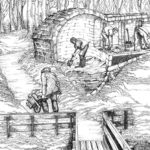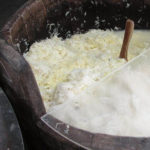 Currently, each of us has a refrigerator and a freezer, and vacuum packaging and freeze drying have become commonplace. Thus, our knowledge of food preservation is limited to checking the use-by date and the list of preservatives on the labels. For our ancestors over a thousand years ago, this problem had a completely different meaning. As far as now it's just a matter of a healthy diet, so much then the survival of the whole family or community could depend on it.
Currently, each of us has a refrigerator and a freezer, and vacuum packaging and freeze drying have become commonplace. Thus, our knowledge of food preservation is limited to checking the use-by date and the list of preservatives on the labels. For our ancestors over a thousand years ago, this problem had a completely different meaning. As far as now it's just a matter of a healthy diet, so much then the survival of the whole family or community could depend on it.
STORING CEREALS AND OTHER SEEDS
Let's start with the ways to store food. Without a doubt, the most valuable food raw material of the Slavs was the grain of cereals. You have to remember, that cereals were stored for direct consumption and as seed. Grain intended for consumption, in order to protect it against germination or decay, was subjected to fire drying or roasting. Thus prepared, it could be stored for a long time, provided that it is protected against moisture. The big ones were used for this, ceramic dishes or special wicker or straw "corks", hulls hollowed in wooden trunks or wooden crates. A very characteristic way of storing grain by the Slavs was storing it in earth pits. Hollow in stable, clay or loess substrate had a characteristic pear-shaped and significant shape, depth up to three meters. A cave discovered in the Bródno district of Warsaw, in which millet and rye were stored in the 10th century, it had wooden walls, bottom – birch sticks and bark, insulating against moisture, and a mono-pitched roof protecting the pit. Interestingly, not only grain was stored in the ground pits, but also other plant products, both from cultivation, as well as gathering. Peas were kept in pits with woven walls discovered in Poznań, and in the pit in Bonikowo, except wheat grains, rye and barley, black elderberry seeds were found. On the grounds, which made it impossible to place supplies in the ground, the grain bins were placed in wooden granaries. Reconstruction of such a granary, situated above the ground on piles, about airy, woven wicker rods on the walls, can be seen at Museumsdorf Duppel in Berlin.
The storage of grain intended for sowing required a lot of care and diligence – it was necessary to protect them not only against premature sprouting during storage, but also against loss of germination. Such grain was kept in especially carefully prepared earth pits. Such cavities, containing large amounts of grain, were discovered in Bruszczewo or Kruszwica in Greater Poland. Before use, they were fired in order to dry and strengthen their walls, and then they were mowed with straw or lined with birch bark, to protect the interior from moisture. In the pits discovered in Tornov and Sandomierz, the walls were reinforced with wooden braid. This method of storing grain intended for sowing was tested in the English center of experimental archeology, Butser Ancient Farm. Turned out, that with proper care for the tight closing of the cavities from above, the grain can be stored for a really long time.











